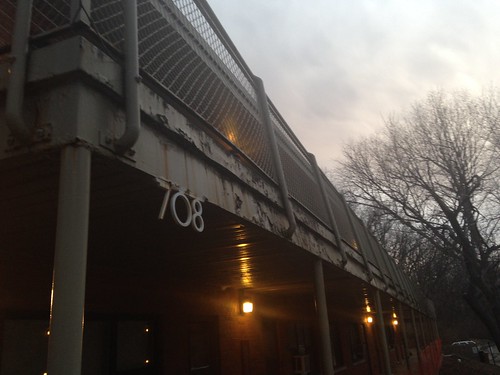 A series of unfortunate -- and preventable -- events
A series of unfortunate -- and preventable -- events
COLUMBIA, Mo 3/4/14 (Op Ed) -- Mizzou library books -- some 600,000, many rare and irreplaceable --
mold in a mediocre and inappropriate storage facility. The University of Missouri's storied publishing arm,
shuttered, then reopened after a firestorm of protest. A
rusty walkway at a student housing facility (
photo) collapses, killing a firefighter.
And now, a Mizzou Press-style backlash begins over closure of a century-old
arts education program, reportedly with little notice to faculty, staff, and students -- the customers who pay the bills, increasingly with tremendous debt.
Do these events signal a
crisis that may affect Mizzou's core mission: student education? Some people -- loyal Mizzou Tigers all -- think so.
"I suggest that the tragic death of fireman Bruce Britt and the wanton destruction of one-fifth of MU's Library books
have the same ultimate causes," said a long-time Mizzou professor who spoke on condition of anonymity. "The underfunding of MU, 'justified' by the anti-public service, anti-tax (for the rich) ideology that prevails in Jefferson City, was responsible for the lack of proper maintenance, oversight and facilities that caused both disasters."
Reports lend credence to this observation. "Mizzou’s Ellis Library had a preservation officer who would have helped prevent mold problems by monitoring the collections,"
KCRG's Mark Slavit reported in January. "But they cut that position several years ago because of budget reasons."
State and Federal budget cuts have shifted more and more of higher education's financial load to students, while ironically shifting management priorities away from students.
Pursuits that create
visibility for administrators -- men's sports (basketball, football); building construction; fancy titles and the salaries that come with them -- are favored as resources become more constrained.
Unglamorous pursuits such as
routine maintenance and low-profile but important programs get the short shrift, often in a cloud of secrecy.
"I would like to have a light shown on the process followed to make such a decision," Mizzou alum and local artist
Marilyn Cummins emailed administrators involved in shuttering the arts education program. "Evidently, it was done without the consultation of faculty or other stakeholders."
Other charges followed, including that administrators "did not provide an accurate account of the total number of certified art teachers graduating each year," according to a
petition to reinstate the program.
"The number of graduates still averages fewer than 10 each year," a news release from College of Education Dean
Daniel Clay explained. "These types of decisions are never easy,
but with limited state resources, we have decided to focus on our post-baccalaureate certification and graduate programs in art education."
Maintenance staff at Mizzou have reportedly complained of "horrible under-funding and under-staffing," a reader close to the situation told the Heart Beat. "Thanks to
chronic under-funding, MU has been obliged to use duck tape to hold things together -- to make short-term fixes for lack of sufficient funds to do things right."

To cope with tight money, university leaders have shifted toward a "run the school like a business" model that revolves around a paradox: hiring a top executive -- the University president -- with no experience in the job at hand, higher education.
With the University of Missouri "a particularly striking example, business expertise and values are creeping their way into universities all over the country," former
Mizzou philosophy professor Zachary Ernst writes. "I strongly suspect that it's a very bad development, coinciding with a
huge increase in the number of administrators, a sustained
attack on tenure, and increasing reliance on non-tenure track, adjunct faculty who are
underpaid, overworked, and without any job security."
Much like the situation Mizzou maintenance staff reportedly face.
This grafting of business onto education fails to recognize how universities differ from corporations.
While business encourages collaboration,
higher education embodies it. University departments are not like corporate divisions that can be shuttered without harming the entire company, a point Cummins and others make in their pitch to save arts education.
"The positive impact of art education goes far beyond a head count of undergraduate art education majors," Cummins writes. The university's collaborative setting has integrated arts education into elementary and early childhood education, Fine Arts, Art History, Journalism, Romance Languages, Business, Psychology, Architectural Studies, and Theatre, to name a few.
It also extends far into the community:
just look at downtown Columbia. From the True/False Film Fest to Orr Street Studios, "The Arts" have become downtown's primary economic and cultural driver, helping create a
block-by-block renaissance that converted vacant, derelict, and unsafe buildings into
brick-and-mortar masterpieces.
"After the fiasco of trying to shut down the University Press, I thought perhaps MU had grown
beyond snap decisions made without sufficient input," Cummins remarked. "There are many creative ways to make better use of resources and/or find new resources IF needs are made public and there is due process."
PHOTOS OF UNIVERSITY VILLAGE-- Mike Martin for the Columbia Heart Beat
A series of unfortunate -- and preventable -- events
COLUMBIA, Mo 3/4/14 (Op Ed) -- Mizzou library books -- some 600,000, many rare and irreplaceable -- mold in a mediocre and inappropriate storage facility. The University of Missouri's storied publishing arm, shuttered, then reopened after a firestorm of protest. A rusty walkway at a student housing facility (photo) collapses, killing a firefighter.